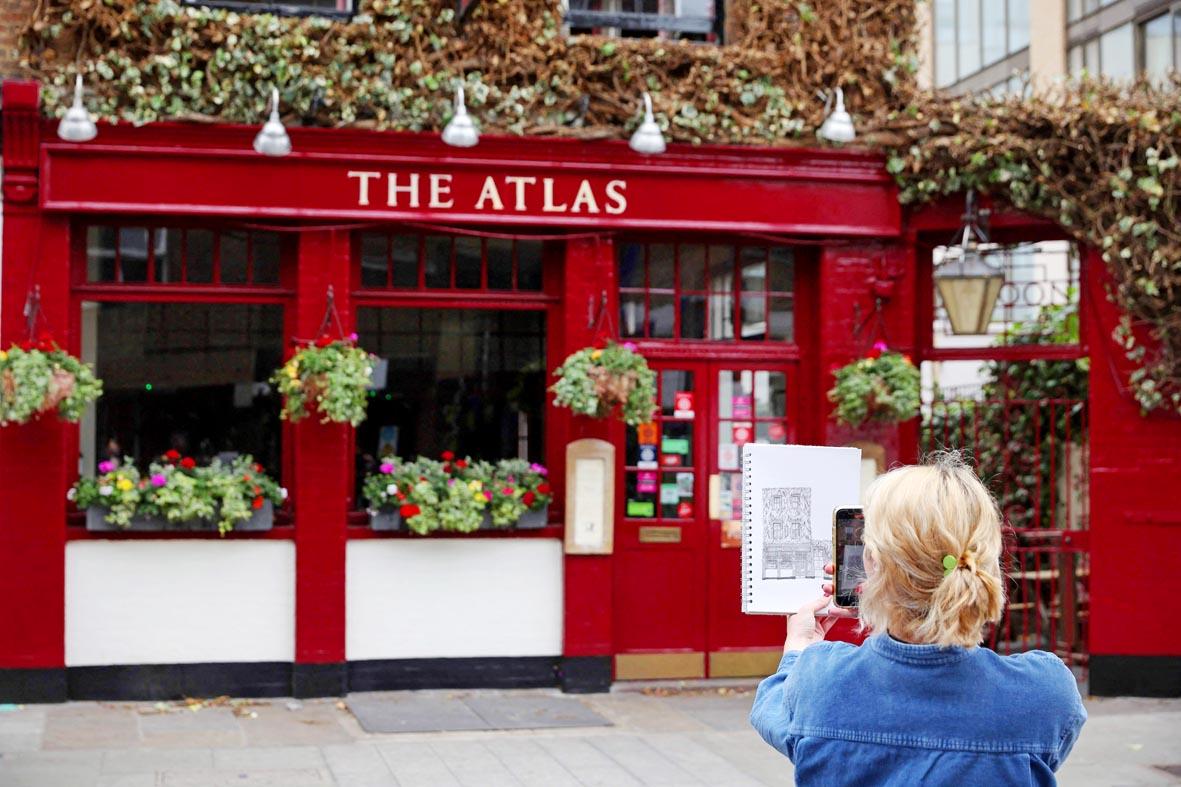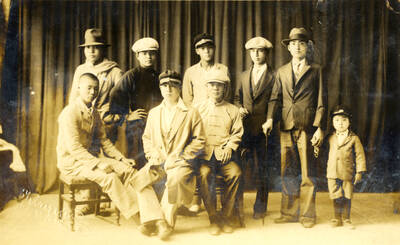Lydia Wood sits opposite The Atlas pub in west London, meticulously adding detail to her drawing of the building and pausing only occasionally to sharpen her pencil.
The 28-year-old artist has built up a sizeable TikTok and Instagram following with her detailed sketches of well-loved London pubs.
She has set an ambitious but, she thinks, not impossible, goal — drawing all 3,500 of them. So far she has managed “a few hundred,” many of them near to her home in Catford, southeast London, she said. The project came about during the coronavirus pandemic when lockdown meant she was unable to work providing children’s after-school art classes.

Photo: AFP
“It did kind of stem from just being, you know, a pub person, like that’s where I socialize with my friends,” she said.
Wood’s drawings get thousands of likes on Instagram and TikTok, where she posts short videos about the process, then holds up the finished sketch in front of the pub.
The freelance artist had always drawn some pictures of pubs to sell at Christmas markets.
But when she announced her plan and asked for commissions to draw the capital’s pubs, “things went a little bit crazy,” she admitted.
Now creating art is her full-time job, mostly carrying out individual commissions, including pubs and houses.
She also sells prints on the e-commerce craft site Etsy.
“They feel so quintessentially British. I think that whether you’re a pub person or not, they’re great buildings to look at or be in.”
‘LOCAL KNOWLEDGE’
The Atlas pub, near Earl’s Court, was suggested by a TikTok follower and sits on a quiet side street near a leafy cemetery.
But Wood still has to put up with screeching ambulances driving past and a plumber’s van unhelpfully parking in front of the building. Some publicans have given her a hearty welcome when they realized she was drawing their buildings.
But The Atlas, its bricks painted glossy red and the upper walls covered with creeper vines, is closed until late afternoon.
Inside, the Victorian-era pub has lovingly preserved period features such as wooden paneling. It is now a “foodie” pub serving dishes such as risotto or confit leg of duck for dinner.
“It looks quite posh,” said Wood.
While she does not see the project as an excuse for a pub crawl, she likes to go into the places she sketches to get a sense of their vibe.
A “local” with regular drinkers has a completely different atmosphere from a central London pub with its transient passing trade.
“When I’ve been inside a pub after I’ve drawn it, there’s definitely a different kind of feeling of ‘oh yeah I know that pub and I can recommend it to someone.’”
‘PEACEFUL’
A few days later, Wood is in busy Soho to draw a very different pub, The Coach and Horses on Greek Street, which she has been into before.
“When you’ve been inside the pub you kind of have a connection to it,” she said.
She chose the pub because a commentator on one of her TikTok videos told her of a family connection to the pub.
Their grandfather, Norman Balon, was famously known as “London’s rudest landlord” and ran the pub for more than 60 years.
“I loved that sort of anecdote,” said Wood. “It immediately drew me towards it.”
The central London pub in a historic 19th-century building has had a colorful clientele, including journalists from satirical magazine Private Eye.
Other regulars included the legendary alcoholic newspaper columnist Jeffrey Bernard, who was immortalized in a Keith Waterhouse play Jeffrey Bernard Is Unwell.
It is now managed by a brewery chain.
On a Saturday afternoon, there is a constant stream of passers-by and drinkers sit with pints outside.
“That took nearly three hours,” she said of her finished drawing of an “iconic part of Soho.”
“It’s funny — there are so many people around, but actually it felt quite a peaceful drawing.”

On April 26, The Lancet published a letter from two doctors at Taichung-based China Medical University Hospital (CMUH) warning that “Taiwan’s Health Care System is on the Brink of Collapse.” The authors said that “Years of policy inaction and mismanagement of resources have led to the National Health Insurance system operating under unsustainable conditions.” The pushback was immediate. Errors in the paper were quickly identified and publicized, to discredit the authors (the hospital apologized). CNA reported that CMUH said the letter described Taiwan in 2021 as having 62 nurses per 10,000 people, when the correct number was 78 nurses per 10,000

As we live longer, our risk of cognitive impairment is increasing. How can we delay the onset of symptoms? Do we have to give up every indulgence or can small changes make a difference? We asked neurologists for tips on how to keep our brains healthy for life. TAKE CARE OF YOUR HEALTH “All of the sensible things that apply to bodily health apply to brain health,” says Suzanne O’Sullivan, a consultant in neurology at the National Hospital for Neurology and Neurosurgery in London, and the author of The Age of Diagnosis. “When you’re 20, you can get away with absolute

May 5 to May 11 What started out as friction between Taiwanese students at Taichung First High School and a Japanese head cook escalated dramatically over the first two weeks of May 1927. It began on April 30 when the cook’s wife knew that lotus starch used in that night’s dinner had rat feces in it, but failed to inform staff until the meal was already prepared. The students believed that her silence was intentional, and filed a complaint. The school’s Japanese administrators sided with the cook’s family, dismissing the students as troublemakers and clamping down on their freedoms — with

As Donald Trump’s executive order in March led to the shuttering of Voice of America (VOA) — the global broadcaster whose roots date back to the fight against Nazi propaganda — he quickly attracted support from figures not used to aligning themselves with any US administration. Trump had ordered the US Agency for Global Media, the federal agency that funds VOA and other groups promoting independent journalism overseas, to be “eliminated to the maximum extent consistent with applicable law.” The decision suddenly halted programming in 49 languages to more than 425 million people. In Moscow, Margarita Simonyan, the hardline editor-in-chief of the